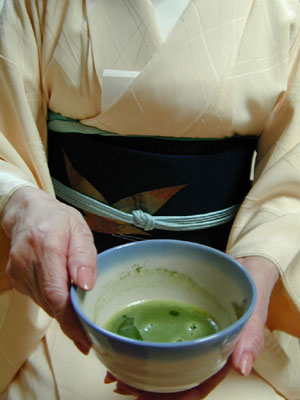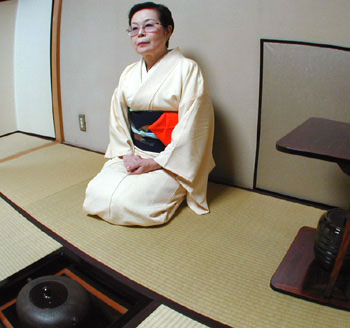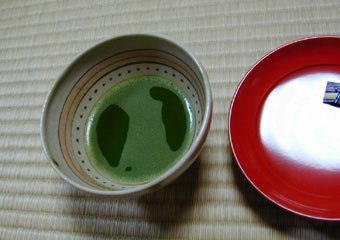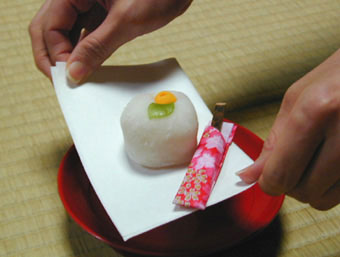Zen in a Teacup: The Way of Tea
 Move inside, and have a seat. Don't be shy. First make your way on down the stone steps, past the trickling pond and small garden hemmed in by cut logs. The tatami room is just beyond the wooden entry gate up ahead. Watch your head as you pass beneath.
Move inside, and have a seat. Don't be shy. First make your way on down the stone steps, past the trickling pond and small garden hemmed in by cut logs. The tatami room is just beyond the wooden entry gate up ahead. Watch your head as you pass beneath.
Now, settle down on the mat, and relax. Turn off that mobile phone, and while you're at it, your mind as well. They're both of no use here.
This is a place of peace. Your mother's constant nagging doesn't exist. As for that gruff office manager sucking air through his teeth, he is in another world, a world you've left behind. Just take it easy.
You've now completed the first step of sado, or the way of tea.
This particular world is courtesy of Soshin Terada, who teaches traditional Japanese tea ceremony (chanoyu) from her apartment in Tokyo's Meguro district.
Like the sumo dohjo, the teahouse is a place of sanctity. It is where one of Japan's most revered cultural institutions takes place.
In truth, the entryway to Terada's teahouse is not quite as grand as initially implied. The garden is plastic and the stones are rubber mats. The gate is merely an enhanced door jam. But the beauty of the tea experience is not in the fineness of the trappings; it lies in capturing a special feeling at a particular time.
"This time today will never come back," says the 72-year old Terada. "This moment is precious. It is not the same as anytime yesterday, and will not be repeated tomorrow. You have to relax and enjoy the tea at this moment. That is the mind of the tea."
 Sound a tad pretentious? Perhaps. But the movements and orchestration of preparation and drinking during chanoyu combine to form a tradition that has been played out for centuries. And even today, with the privacy of folks' lives being squeezed by technology and work demands alike, experiencing the way of tea still fills a prominent place in the hearts and - more importantly - minds of Japanese, if even for just a moment.
Sound a tad pretentious? Perhaps. But the movements and orchestration of preparation and drinking during chanoyu combine to form a tradition that has been played out for centuries. And even today, with the privacy of folks' lives being squeezed by technology and work demands alike, experiencing the way of tea still fills a prominent place in the hearts and - more importantly - minds of Japanese, if even for just a moment.
A mere cup of joe at the corner diner this is not. Each movement in the preparation has been rehearsed thousands of times over the roughly ten years it takes to become a teacher of the craft.
From the seiza position (feet tucked underneath behind), the hostess works between the kettle and wood table with the precision of a draftsman and fluidity of a ballerina.
The entire process is utilitarian in nature. Everything has a function or purpose - the wood whisks, the thin scoops, the adjustments to the water temperature, the mixing, everything. The relative location of the kettle, table, and even the flower vase in the corner are all set by careful measurement down to the centimeter.
This attention to detail and effort on the part of the hostess is part of the pleasure. "[Enjoyment] involves appreciation of the teahouse, the utensils, a quiet atmosphere, and gratitude for the host's warm hospitality," says Yumiko, 35, a secretary, who started participating in tea ceremony at the age of ten at the urging of her mother, an instructor.
 For the two largest chanoyu styles in Japan, omotesenke and urasenke, the tea starts as a fine green powder, or matcha. After the hostess scoops a few spoonfuls of matcha into a bowl, a wood ladle is used to add the water from the kettle.
For the two largest chanoyu styles in Japan, omotesenke and urasenke, the tea starts as a fine green powder, or matcha. After the hostess scoops a few spoonfuls of matcha into a bowl, a wood ladle is used to add the water from the kettle.
"The best-tasting tea is drawn from the best water," explains Terada, adorned in a yellow kimono with blue obi (belt), as she lifts the lid on the black water kettle nestled within the floor in the center of the room. She says that using pure water with an appropriate mineral content is as important to tea as it is to sake or wine.
She then vigorously whisks the concoction like a chef will beat egg. When it is possess a white foam on its surface it is ready.
Guests, seated in the same catcher-blocking-the-plate position, are fanned out opposite the hostess. WIth the decorative piece of sweet omogashi (cake) placed before them already eaten, it is now time for the piece d' resistance - the drinking of the tea itself.
After retrieving a bowl and performing a few appropriate bows, each guest will hold the cup with both hands so that the painted image is facing the drinker. At this moment, Terada encourages a peek at the pattern of the floating foam bunched up against the sides of the cup. "You can see the bubbles, but the clear areas resemble islands floating in the ocean in shapes that will never be repeated," she explains. "This particular tea is unique; it can only be enjoyed this one time. This is part of the command of tea."
 The drinking is an aesthetic all its own. With the palm as a pivot point, the bowl is rotated clockwise a quarter turn. Then it is turned once more so that the image faces the hostess - a small sign of respect for her hospitality. Now it's down the hatch.
The drinking is an aesthetic all its own. With the palm as a pivot point, the bowl is rotated clockwise a quarter turn. Then it is turned once more so that the image faces the hostess - a small sign of respect for her hospitality. Now it's down the hatch.
The experience is a form of therapy. Terada relates: "Sometimes a 40-year old lady will call me. Overwhelmed by stress at work, she'll just want to come over for a break. People are attracted to the old-style feeling of the experience; it is healing."
Such stringent codes of conduct within the ceremony have not always been the case. Sen no Rikyu, a Monk born into a wealthy trading family, completely revolutionized the ceremony in the sixteenth century. At the time, tea was something to be enjoyed by the aristocracy (of which his family belonged). Searching for more of an egalitarian image for tea, he stripped the teahouse of any excess, developed strict rules of behavior, and emphasized the Zen principles of finding internal worth within oneself.
Terada insists that for such introspection on the part of her guests it is important that her teahouse reflect the spirit of the season. The painted scroll hanging on the back wall today reads, "One flower blooms, spring is coming." The image on the side of the ceramic teacups depict rabbits frolicking in a meadow. These combine to contribute to "the mind of the hosting," she says.
 For Terada, she feels lucky to have had such a rewarding job. Her 32 years as an instructor have allowed her to see women's roles within society chance. She notes that when she began teaching - during Japan's period of great economic growth - most of her students were hobby-seeking housewives with grown children. Today she teaches primarily young, single women and even a few men in her weekday classes.
For Terada, she feels lucky to have had such a rewarding job. Her 32 years as an instructor have allowed her to see women's roles within society chance. She notes that when she began teaching - during Japan's period of great economic growth - most of her students were hobby-seeking housewives with grown children. Today she teaches primarily young, single women and even a few men in her weekday classes.
Still, to view the tea ceremony as a bit of an anachronism in modern Japan doesn't take much deep thinking. Such daily distractions as ringing mobile phones and the convenience of canned drinks are difficult to link to the meditating monks of 400 years ago.
But balance is the key. After all, there can be time for everything these days, even Zen. "The important thing is to savor the richness of your own spirit," Yumiko says. "It is totally different from having a coffee at Starbucks. Though I do like Starbucks' cappuccino."
Note: Tomoko Nakayama contributed to this report from the Chiba Bureau.
